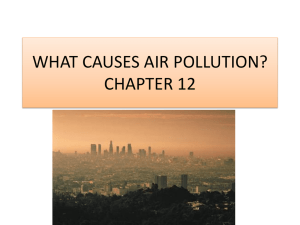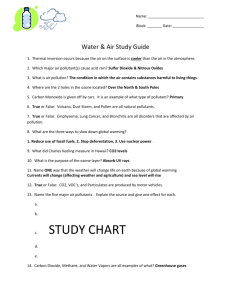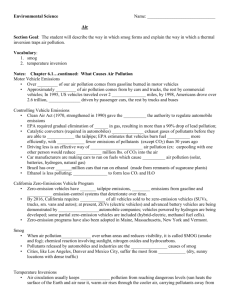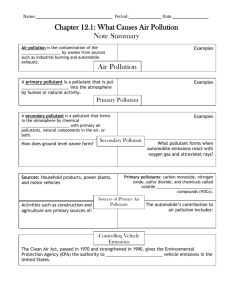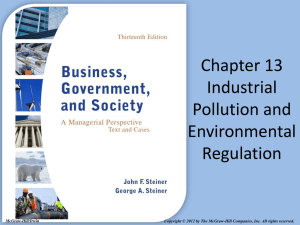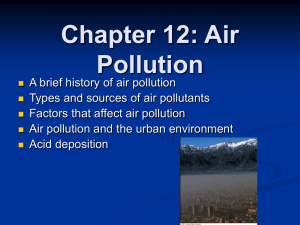#15 - What Causes Air Pollution? Section 12.1
advertisement
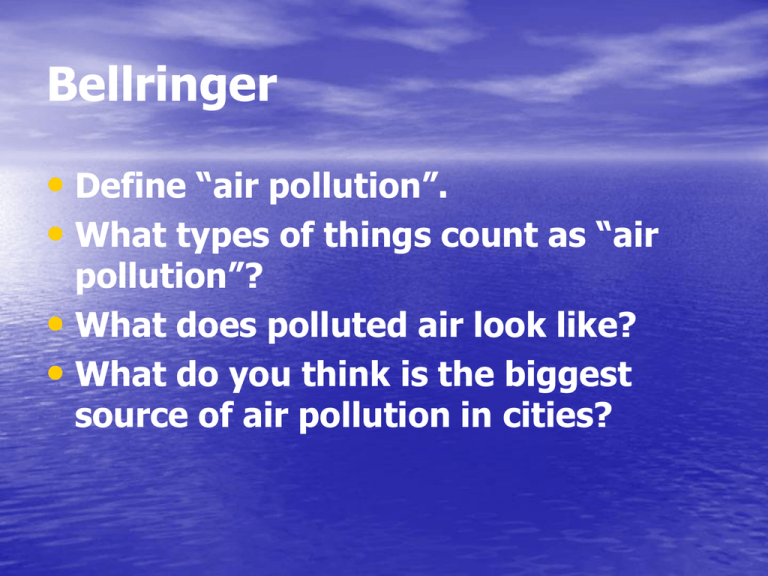
Bellringer • Define “air pollution”. • What types of things count as “air pollution”? • What does polluted air look like? • What do you think is the biggest source of air pollution in cities? #15 - What Causes Air Pollution? Section 12.1 Objectives: 1. Name 5 primary air pollutants, and give sources for each. 2. Name the 2 major sources of air pollution in urban areas. 3. Describe how smog forms. Define “air pollution” • When harmful substances build up in the air to unhealthy levels. – Human activities – Natural sources • Compare cigarette smoke and pollution (Lanzhou, China) • Cigarette manufacturers vs. industries – legal responsibilities Primary and Secondary Pollutants • Primary pollutants: a pollutant put directly • into the air by human activity (EX: soot from smoke) Secondary pollutant: forms when a primary pollutant comes into contact with other primary pollutants or with naturally occurring substances, such as water vapor, and a chemical reaction takes place (EX: ground-level ozone formed from vehicle emissions reacting with UV rays and mixing with oxygen) What color is polluted air? • Primary Air Pollutants (Table 1, p.304) Sources of Primary Air Pollutants (Fig.1, p.303) Smog • Definition: pollution that hangs over urban areas and reduces visibility • Smog is formed when: 1. Car emissions combine with sunlight and air to form ozone. 2. Car emissions + ozone = smog • What is the importance of ozone alerts? • “Valley of the Smokes” - LA Temperature Inversion • How does temperature change with elevation? • When warm air rises, it carries air pollutants with it, removing them from air at the surface. • Temperature inversion: the air above is warmer than the air below. • The warmer air above traps the cooler air (and pollutants) at the surface. Reducing Air Pollution • King Edward II (1273): “Off with his head!” • What attempts can you think of that have been used to try to reduce air pollution? Regulating Motor Vehicle Emissions • Clean Air Act (1970; 1990) – EPA regulates vehicle emissions – Leaded gasoline • Zero-Emission Vehicle Programs – Electric vehicles – Advanced battery vehicles – Hydrogen fuel – Partial zero-emissions vehicles Industrial Air Pollution • How do factories and power plants make electricity? • Power plants the produce electricity ALSO produce 2/3 of all sulfur dioxide and 1/3 of all nitrogen oxides that pollute the air. • Clean Air Act requires many industries to “scrub” or filter their emissions – spray the gases with water to dissolve pollutants. Group Discussion • How do you contribute to air pollution? • At what point would the level of air pollutants be high enough for you to take action? • Should automobile makers be made to adhere to quotas of zero-emission vehicles set by states, even if the quota causes automakers to lose revenues? Support your stand. Review • On the board, list as many causes of air pollution as possible. • Exit Slip Assignment: Place the causes in the appropriate category. (NOTE: Causes may fall into more than one category.): 1. Industrial and Commercial 2. Transportation 3. Noncommercial KNOW FOR TEST!!! • Section Review questions 1-4 (p.308)



